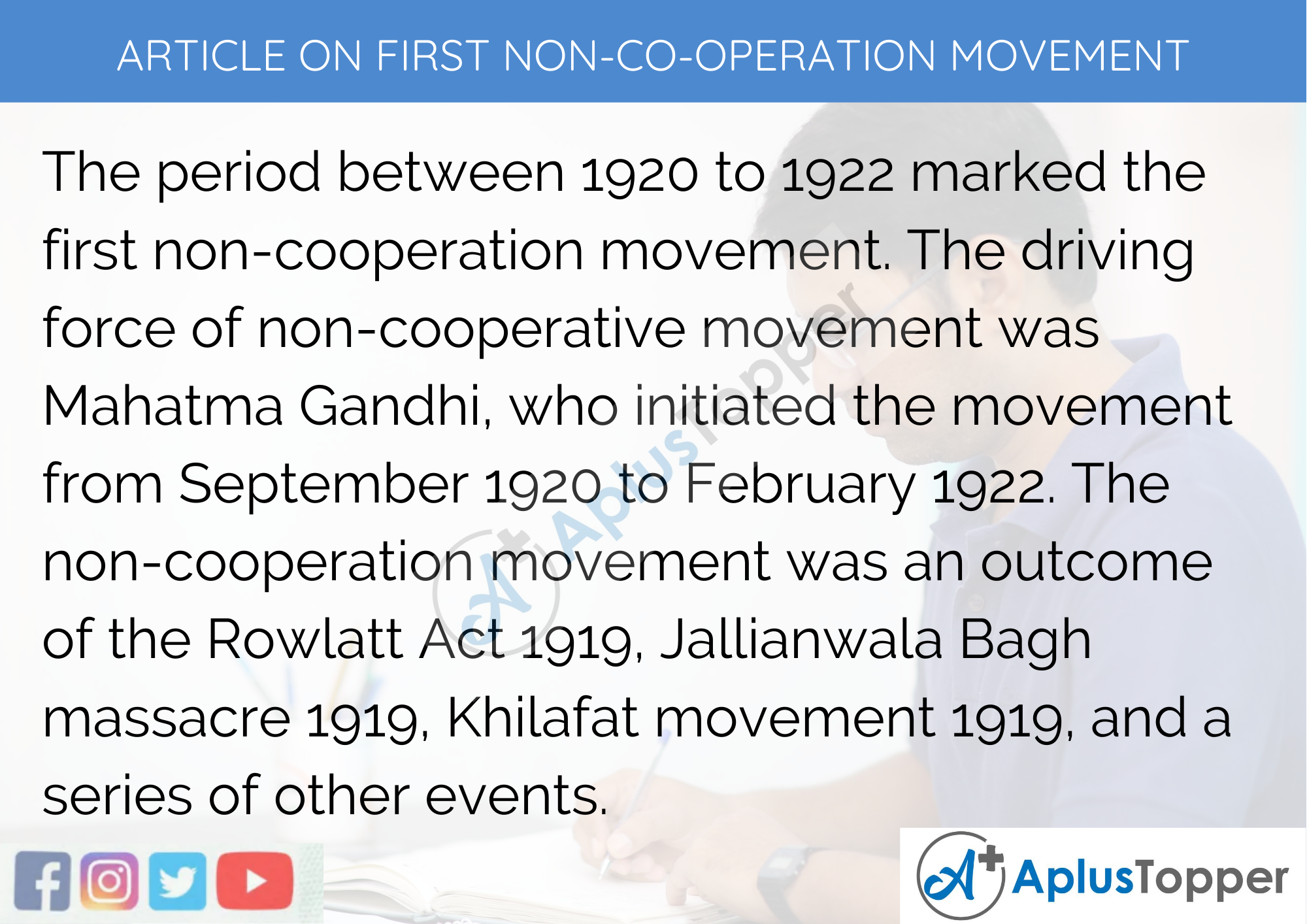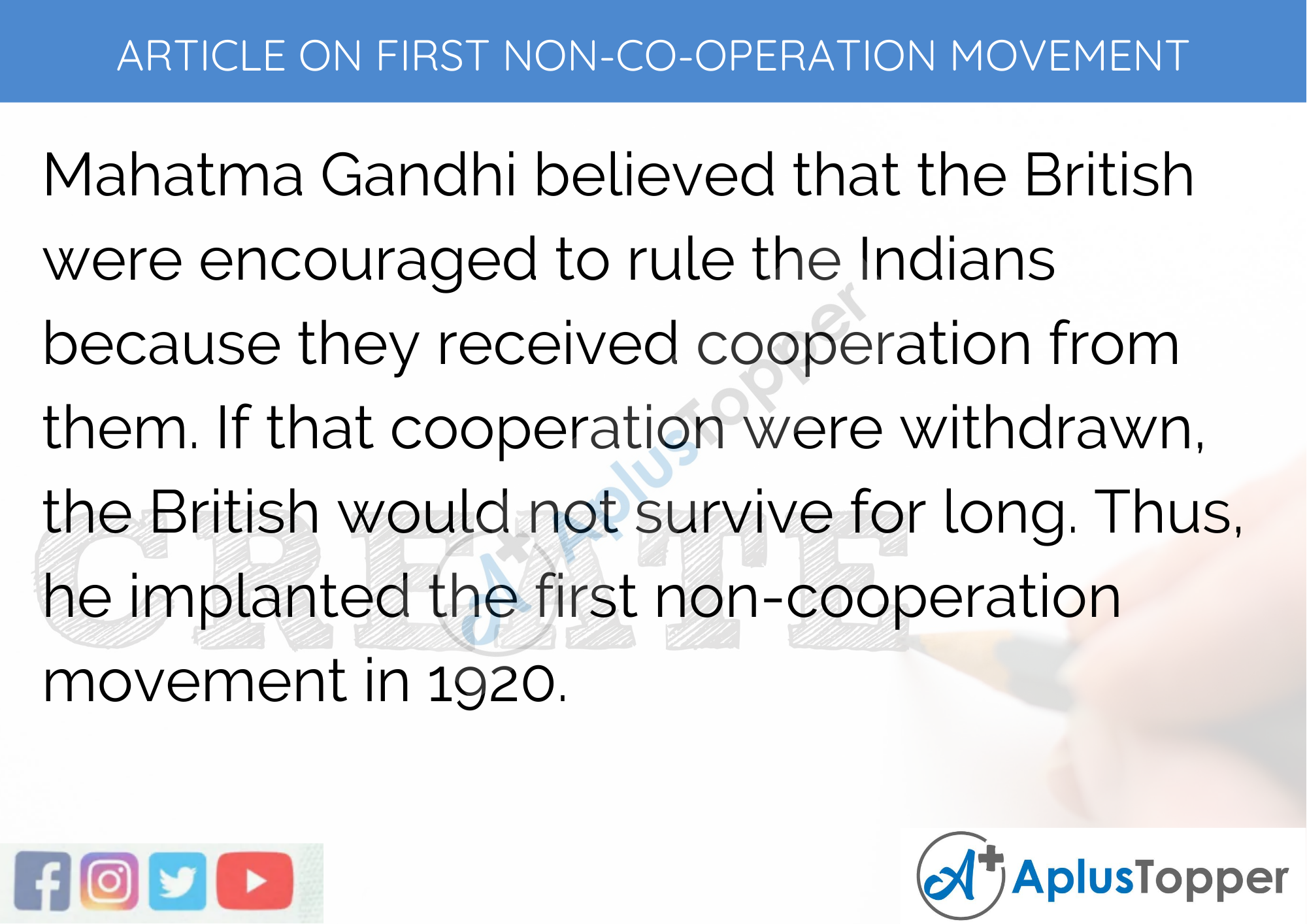Article on First Non Co-operation Movement 1920 to 1922: When we think of the independence of India, we recall the non-cooperation movement led by Mahatma Gandhi. He was a new awakening with his innovative ideologies to lift the status of the country and its fellow countrymen. The first non-cooperative movement etched a development that goes down the history. Leaders of superpowers also bowed down to the principles of Mahatma Gandhi and were immensely influenced by the non-cooperative movement of 1920 – 1922.
You can read more Article Writing about people, sports, technology many more.
Long and Short articles on the First Non-Cooperation Movement 1920 to 1922 in English for Students and Children
Here, you will find two types of articles on the topic, the first non-co-operation movement from 1920 to 1922. The first is a lengthy article, which consists of 400 – 500 words. On the other hand, the second article is a brief one comprising 200 words. The long article is helpful for students preparing for competitive examinations, assignments, etc. Furthermore, teachers can also use this as a base to help students refine themselves in co-curricular activities, such as debates, extempore, speeches, article writing, etc. The short article for 200 words is an excellent piece for children and kids. It will assist them with their projects, assignments, class activities, etc.

Long Article on First Non-Cooperation Movement from 1920 to 1922 in English 500 Words
The long article given below on the first non-cooperation Movement from 1920 to 1922 is useful for aspirants of competitive exams. It is suitable for students studying in classes 6, 7, 8, 9, and 10. With this article’s help, children can make progress in their classwork, home assignments, reading and writing comprehension, article writing tasks, and preparation for competitive examinations. Long Article About the First Non-Cooperation Movement from 1920 to 1922 in English for Students of Class 6, 7, 8, 9, and 10.
The period between 1920 to 1922 marked the first non-cooperation movement. The driving force of non-cooperative movement was Mahatma Gandhi, who initiated the movement from September 1920 to February 1922. The non-cooperation movement was an outcome of the Rowlatt Act 1919, Jallianwala Bagh massacre 1919, Khilafat movement 1919, and a series of other events.
The Rowlatt Act 1919
The Rowlatt Act of 1919 passed a law, which restricted people’s right to freedom. It issued powers to the government to arrest and imprison people without a warrant or trial. Gandhiji was against this Act and held a Satyagraha Sabha. He called upon the citizens to support the anti-Rowlatt Act by non-violent strikes and demonstrations.
The Jallianwala Bagh Massacre 1919
General Dyer, the military commander of Amritsar, ordered indiscriminate fire on thousands of innocents in a closed complex of Jallianwala Bagh on 13th April 1919 on the eve of the festival. Sikhs, Hindus, and Muslims withdrew their loyalty towards British Rule after the episode of Amritsar mass killing. Rabindranath Tagore launched a protest against the British.
Khilafat Movement 1919
Indian Muslims expressed their anger when Britain imposed disgraceful terms on the caliph of Islam or the Turkey’s ruler. The Khilafat Movement was launched under the leadership of Abdul Kalam Azad, Shaukat Ali, and Muhammad Ali. Mahatma Gandhi joined the movement and combined the non-cooperation movement to it.
Non-cooperation Movement 1920-22
To redress the wrong, Gandhi evoked millions of Indians to Gandhi’s first non-cooperation movement. His pursuit wanted to bring justice to people killed in Amritsar, and the wrong done to the people of Turkey. The principles of the non-cooperation movement restricted each member from indulging in violent acts irrespective of the degree of British cruelty inflicted upon them.
Congress set up an all-India working committee at Nagpur. Men and women above 21 years old were invited to join in, aiming for swaraj. The committee’s objective was to boycott foreign-made goods, educational institutions, legislature, and courts. They burnt British-made goods, did not adhere to their law, boycotted the council election, and renounced British titles and honours. Several prominent leaders, such as Subhash Chandra Bose, Rajendra Prasad, Motilal Nehru, C.R. Das, and C. Rajagopalchari, joined the movement.
The non-cooperation movement further strengthened by issuing effective programmes under the Congress party. It promoted national education and cottage industries. Subhash Chandra Bose and Jawaharlal Nehru included socialism as one of the objectives of Congress’s plan to provide equal opportunities to everyone in society. Socialism was an effort to remove all kinds of social suppression. It also worked towards improving the working conditions of peasants and labourers.
Uniting Nation with Non-cooperative Movement
The non-cooperative movement sent a wave of unity across the nation to press for an independent nation. With the support of Congress, peasants of Uttar Pradesh, Bihar, and Bengal released no-tax campaigns. Furthermore, the tribal of India arranged satyagrahas to allow them the right to use the resources and lift the taxes. Some launched nation-wide movements against oppressive landowners, corrupt mahants of gurudwaras, strikes to raise wages, etc.
British Response
In response to satyagrahas and non-cooperation movement, the British government banned the Congress and imprisoned its leaders and volunteers. Gandhiji retaliated with a civil disobedience act to discontinue repression.
Fall of Non-cooperative Movement
In February 1922, some non-cooperation activists torched the police station at Chauri Chaura, Uttar Pradesh, which killed twenty-two policemen. The violent act was against the principles of the non-cooperation movement and Gandhiji’s belief. Thus, Gandhiji suspended the non-cooperation movement in 1922, citing that people are not ready to cooperate under the mass civil disobedience movement.
Though the non-cooperation movement died abruptly, it lit the torch of a mass movement for India’s independence.
Short Article on First Non-Co-operation Movement 1920 to 1922 in English 300 Words
The article of 200 words is a short one. It is suitable for kids and children up to the sixth standard. The article is a guide to the children for their school assignments, comprehension, writing skills, etc. Short Article About the First Non-Cooperation Movement 1920 to 1922 in English for Students of Classes 1, 2, 3, 4, 5 and 6.
Mahatma Gandhi believed that the British were encouraged to rule the Indians because they received cooperation from them. If that cooperation were withdrawn, the British would not survive for long. Thus, he implanted the first non-cooperation movement in 1920.
A series of events, such as the Rowlatt Act 1919, Jallianwala Bagh massacre 1919, and Khilafat movement 1919, brought discontentment among the Indians. People grew rebellious. Mahatma Gandhi launched the first non-cooperative to channelize their anger against the British. He proposed that the movement would be multi-fold.
Under the first non-cooperative movement, people would begin with surrendering titles, awards, etc. received from the British. Furthermore, people boycotted civil services, legislative councils, army, police, and courts. They shunned schools, colleges, and universities under British authority. Moreover, they burnt foreign-made goods and accepted swadeshi products. Mahatma Gandhi and Shaukat Ali travelled across India to make Indians aware of their movement.
Furthermore, to encounter the government’s repression, the civil disobedience campaign would be launched for unreasonable arrests and imprisonment. In November 1920, people boycotted the council elections. At the Congress session held in December 1920 at Nagpur, the first non-cooperation movement’s programme was announced. Several known leaders, such as Subhash Chandra Bose, Rajendra Prasad, Motilal Nehru, C.R. Das, and C. Rajagopalchari, joined the movement.
Gradually, the first non-cooperation movement spread to the countryside among peasants and labourers who protested against poor wages and working conditions. People across the country refused to pay taxes and raised their voices against the cruelty of landlords. The Congress party redress the grievances of the villagers, peasants, tribal, etc. Congress tried to uplift education, employment, industrialism, social, and economic conditions of India without the British’s help.
The non-cooperation movement was misinterpreted by different people differently. At Chauri Chaura in Gorakhpur, the Gundem rebels carried out guerrilla warfare to achieve swaraj. They set fire to a police station and attempted to kill British officials. Mahatma Gandhi was disappointed by their actions and decided to halt the non-cooperation movement.

10 Lines on First Non-cooperation Movement 1920-1922
- The first non-cooperation movement was set up by Mahatma Gandhi on 5th September 1920.
- He had a vision of free India and aimed for self-governance.
- The movement was launched to withdraw the cooperation Indians extended to the British.
- The principles of the movement were based on non-violence and satyagraha.
- The non-cooperation movement also involved withdrawing labourers, peasants, government officials, etc. to supply their services to the British government.
- The movement inculcates the habit of self-dependence and self-reliance.
- Several known leaders, such as Subhash Chandra Bose, Rajendra Prasad, Motilal Nehru, CR Das, and C. Rajagopalchari, were also a part of the movement.
- Protesters refused to buy British goods, shunned their educational institutions, legislation, court, etc. to cripple their control over the Indians.
- The movement spread to the countryside and every corner of the nation.
- On 10 March 1922, after the Chauri Chaura incident, Gandhiji was disappointed by the rebellious attempt to kill British police. He called off the movement.
FAQ’s on Article on First Non Co-operation Movement 1920 to 1922
Question 1.
What is the first non-cooperation movement of 1920-1922?
Answer:
The non-cooperation movement of 1920 – 1922 was to stop all activities related to cooperating with the British ruling the Indian. The movement would obstruct the smooth functioning of the British government.
Question 2.
Who were the prominent leaders that participated in the first non-cooperation movement 1920-22?
Answer:
Several prominent leaders, such as Subhash Chandra Bose, Rajendra Prasad, Motilal Nehru, C.R. Das, and C. Rajagopalchari, were active participants.
Question 3.
What was the purpose of the first non-cooperation movement?
Answer:
The purpose of the first non-cooperation movement was to cripple the British government’s rule in India by boycotting foreign-goods, services extended to British authorities, educational institutions, legislature, and courts, renounced British titles, and honours.
Question 4.
Who called off the first non-cooperation movement 1920-22?
Answer:
After the Chaura Chauri incident at Gorakhpur, Gandhiji was disappointed with rebels attempting to kill the British personnel. So, Gandhiji called off the first non-cooperation movement that lasted between 1920 to 1922.
